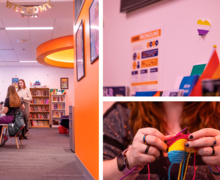With tight rotations abound in NCAA Tournament, importance placed on deep bench minimized
Margaret Lin | Senior Staff Photographer
Chinonso Obokoh is on Syracuse's bench and hardly plays. The Orange, like many NCAA Tournament teams, don't need a deep bench for success.
CHICAGO — Having depth really can’t hurt a program, but for a large chunk of the remaining 16 teams vying for a National Championship, it certainly hasn’t helped. Seven of those teams are ranked No. 330 or lower (out of 351) in percentage of bench minutes, per KenPom. The team with the most depth left is Indiana, and it was ranked 51st in Division I this season.
When Syracuse (21-13, 9-9 Atlantic Coast) faces off against Gonzaga (28-7, 15-3 West Coast) at 9:40 on Friday at the United Center, it will be the lowest combination of bench minutes of any Sweet 16 games. The Orange uses its bench 16.2 percent of the time (No. 350) and the Bulldogs do 22.9 percent of the time (No. 338).
“If the minutes are like that,” Gonzaga bench player Dustin Triano said, “then it proves it wrong.”
“It”, in this situation is the idea that a large bench is necessary to finding NCAA Tournament success. Syracuse head coach Jim Boeheim has said multiple times this year that he is unconcerned about his tight seven-man rotation. The Gonzaga players say it forces them to be more conscious about silly fouls and conserving energy.
MORE COVERAGE:
- Syracuse’s practice time thrown out of whack by late game
- Syracuse basketball players vote for best and worst dancers on team before ‘Big Dance’ Sweet 16
- LIVE BLOG: Follow along during Media Day for Syracuse and Gonzaga in Chicago
- Syracuse basketball predictions for Sweet 16 matchup with Gonzaga
- For Brad Pike, planning Syracuse’s meals requires close attention to detail
In the NCAA Tournament, there are extended timeouts (two minutes and 30 seconds) and longer halftimes (20 minutes). The games are dragged out and there’s far more recovery time for teams that use fewer players — which at this juncture in the Tournament is quite a bit.
Gonzaga head coach Mark Few still said he’d rather have a bench that ran 10 deep that was able to sustain foul trouble. He added, though, that players like Kyle Wiltjer and Domantas Sibonas have actually have grown the most this year because they’re conscious of the fact that they need to be on the floor so much.
On the other end of the spectrum, Boeheim said after a loss in February that he would have used someone else besides Tyler Roberson, but there were no other options. It’s led to Michael Gbinije being the No. 11 most used player in college basketball and Trevor Cooney being No. 41, despite the fact he plays less with the emergence of Frank Howard.
Both Syracuse and Gonzaga have played their season with a tight rotation — but so too has Iowa State (No. 348), Duke (No. 346), Notre Dame (No. 344), Wisconsin (No. 339) and Oklahoma (No. 331).
Depth is nice to have, and sometimes it can show itself in different ways. A team might have capable players that it doesn’t necessarily use. But this Tournament shows that a deep rotation doesn’t mean as much as it’s cracked up to be.
“Makes things a lot simpler when you’re sitting on the bench,” Few said about his job. “You don’t have to worry about subbing so much.”
Published on March 24, 2016 at 5:40 pm
Related Stories
- Syracuse basketball opponent preview: What to know about Gonzaga
- Blum: Syracuse playing rest of NCAA Tournament on borrowed time
- Why Tyler Roberson can be a consistently dominant rebounder for Syracuse
- Syracuse basketball roundtable: How to handle Gonzaga's threats and how SU can improve
- How Dajuan Coleman can provide an added bonus for Syracuse






